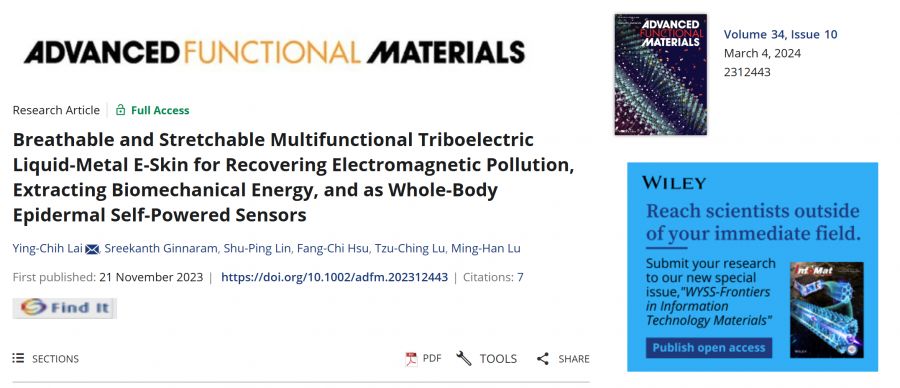設施農業:農業綠能開發與碳匯補償【材料科學與工程學系賴盈至 特聘教授】
| 論文篇名 | 英文:Breathable and Stretchable Multifunctional Triboelectric Liquid-Metal E-Skin for Recovering Electromagnetic Pollution, Extracting Biomechanical Energy, and as Whole-Body Epidermal Self-Powered Sensors 中文:透氣且可拉伸的多功能摩擦電液態金屬電子皮膚,用於可回收電磁污染、提取生物機械能,以及作為全身表皮自供電感測器 |
| 期刊名稱 | Advanced Functional Materials |
| 發表年份,卷數,起迄頁數 | 2024, 34(10), 2312443 |
| 作者 | Lai, Ying-Chih(賴盈至)*; Ginnaram, Sreekanth; Lin, Shu-Ping; Hsu, Fang-Chi; Lu, Tzu-Ching; Lu, Ming-Han |
| DOI | 10.1002/adfm.202312443 |
| 中文摘要 | 皮膚電子設備可以舒適地部署在身體上,用於健康監測、輔助生活和人機介面。然而,開發相應的能源設備是一個嚴峻的挑戰。在此,我們提出一種可滲透且可拉伸的多功能液態金屬能源回收電子皮膚,它可以透過回收環境電磁污染(來自周圍電器)和生物機械能(來自身體運動)來發電,用於表皮能量和自供電感測應用。這是首次證明透氣的皮膚裝置可以將環境電磁污染轉化為有用的電力。本元件採用兩層可拉伸微纖維薄膜構成,中間夾有自組織網狀和褶皺液態金屬,透過感應起電(±9.3 V,±1.7 µA;60 Hz)和摩擦起電(205.6 V,± 2.3 µA;4 Hz)提供電力。其在為電子設備供電方面的適用性得到證明。此外,它可以作為表皮自供電感測器,連續監測眼瞼、臉部、喉嚨、胸部和四肢的全身生理訊號和運動,從而展示其遠端收集臨床和生物力學資訊的潛力。最後,它被用作各種系統級應用程式的介面。這些結果揭示能量和感測的新方向,能夠引領電子產品走向不受束縛和多樣化的應用。 |
| 英文摘要 | On-skin electronics can be conformably deployed on body for health monitoring, assisted living, and human/computer interfaces. However, developing corresponding energy devices is a critical challenge. Herein, a permeable and stretchable multifunctional liquid-metal electronic skin that can generate electricity by recovering ambient electromagnetic pollution (from surrounding electrical appliances) and biomechanical energy (from body movements) is presented for epidermal energy and self-powered sensing applications. To the best of the authors' knowledge, this is the first demonstration that a breathable on-skin device can convert ambient electromagnetic pollution into useful electricity. The device is constructed using two stretchable microfibrous films sandwiching self-organized mesh-like and wrinkled liquid-metal that affords electricity via induced electrification (±9.3 V, ±1.7 µA; 60 Hz) and triboelectricity (205.6 V, ±2.3 µA; 4 Hz). Its applicability in powering electronic devices is demonstrated. Moreover, it can serve as an epidermal self-powered sensor for continuously monitoring whole-body physiological signals and motions of the eyelids, face, throat, chest, and limbs, thus demonstrating its potential to remotely collect clinical and biomechanical information. Finally, it is used as an interface in diverse system-level applications. These results shed light on new directions in on-skin energy and sensing, enabling to usher electronics toward untethered and diversified applications. |
| 發表成果與本中心研究主題相關性 | 新能源擷取、物聯網自發電感測 |







